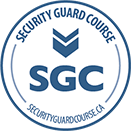This is why we offer the Online Use of Force Training Course, which will help you learn how to protect yourself if needed, and when and if it’s appropriate on the job. It provides additional security training that will not only make you more marketable, it will teach you how to keep legally and ethically safe when using force to protect yourself on the job.
Participants who complete this course are awarded a Use of Force and Basic Handcuffing Certificate.
Do Security Guards have the same authority as the Police?
No. Security professionals are not police and can not operate in the same ways that a police officer would. It is imperative for the safety and liability of Security Guards and the client or company that employs them, that a guard effectively operates within the boundaries they are given. But what does that mean? While performing security duties, a guard must be able to assess when and how to apply force in a threatening situation and if the application of force is necessary.
How much force can a Security Guard use?
In general, security guards and bouncers are tasked with keeping their assigned property reasonably safe, and are allowed to use force to carry out their duties, if necessary. According to Section 25 of the Criminal Code of Canada, an Ontario Security Guard is permitted to use: “as much force as is necessary as long as they act on reasonable grounds. However, section 26 states that individuals who use force are also criminally responsible for any excess of force in these circumstances.” So, it is important to use the minimal use of force required to perform your duties.
How to assess how much force to use?
A responsible security guard will consider the situation, the conditions, and other factors when deciding whether or not it is in his/her best interest to use force. How do you know what those situations are, and the amount of force that is considered “reasonable?”
This can be tricky. You don’t want to do anyone harm and you don’t want to put yourself at risk physically or legally. Understanding the parameters of when to use force and what how much is outlined in our Use of Force course.
The Advantages of completing our Use of Force Training Course
There are several advantages to receiving your Use of Force Certification. They are:
Protection from harm: Learn self defense techniques to keep you safe on the job.
Protection from legal liability: Understanding what constitutes reasonable force and the parameters a guard must operate under will make sure you are operating legally.
Increase your qualifications within the security industry: Receiving proper training in Passive Handcuffing as well as Passive Search and receive a Use of Force Certificate issued by a Subject Matter Expert and verified Vendor of Record for training Provincial Officers in Ontario.
Why take this course with SGC?
- It was written by a Subject Matter Expert in this field and former Instructor trainer for the Ontario Police College.
- There is no requirement for an in class, hands on training module in order to become certified.
- As an added bonus you will get the Handcuffing and Search modules and downloadable pdfs to keep.
- Seek higher paying work and improve your chances of landing jobs by proactively taking this training.
- Ability to complete this course at your own pace.
- Instructor expertise and assistance available through email.
What topics will be covered?
USE OF FORCE ONLINE COURSE INTRODUCTION
Lecture 2.1 Introduction to Use of Force
CRIMINAL CODE USE OF FORCE SECTIONS
Lecture 3.1 Criminal Code Use of Force Sections
Lecture 3.2 Mall Security Legal Issues
Lecture 3.3 Criminal Code Arrest By Security Guards
INTRODUCTION TO USE OF FORCE ACADEMICS
Lecture 4.1 Introduction to Use of Force Related Academics
USE OF FORCE AND INCIDENT ARTICULATION
Lecture 5.1 Use of Force and Incident Articulation
INTRODUCTION TO PASSIVE HANDCUFFING
Lecture 6.1 Introduction To Passive Handcuffing
ACTIVE / NON-COMPLIANT HANDCUFFING
Lecture 7.1 Active / Non-Compliant Handcuffing
INTRODUCTION TO PASSIVE SEARCH
Lecture 8.1 Introduction To Passive Search
USE OF FORCE FINAL EXAM
Lecture 9.1 Final Exam
Quiz 9.1 Recap Quiz[/vc_column_text][/vc_column][/vc_row][vc_row][vc_column][/vc_column][/vc_row][vc_row][vc_column][/vc_column][/vc_row]








